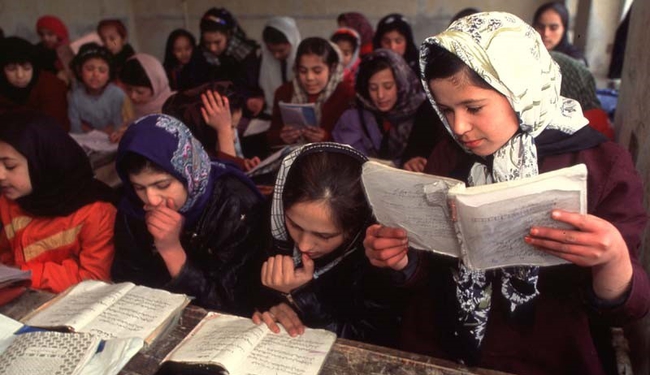Three promising initiatives from Afghanistan, India, and Nepal have been successful at keeping girls in school and improving their learning achievement.
The global picture of girls’ learning achievement is mixed. In many middle and high-income countries, girls outperform boys in language and literacy, while boys outperform girls in mathematics—signalling that work needs to be done with both boys and girls to achieve parity in all school subjects. But in other countries, girls still perform worse than boys across the board. Basic literacy rates for women remain lower than that of men, and girls’ secondary and tertiary level educational attainment is also far behind that of boys in many regions of the world, influencing their ability to develop higher-level skills and knowledge.
The 2016 Global Education Monitoring Report Gender Review recognizes that gender inequities in educational attainment and learning outcomes are rooted in complex issues that stretch far beyond the school—socio-cultural gender norms, labour market conditions, male dominance in positions of leadership and political participation, and inter-generational patterns of gender-based violence, to name a few. By focusing on school inputs and processes, but also on community support and on the surrounding context, the following initiatives illustrate that more can be done to bolster girls’ learning achievement in places where it still falls behind.
Afghanistan: The School in a Box Model, Womanity Foundation
School in a Box is an intensive whole-school approach for developing individual institutions into models of quality girls’ education through a three-year intervention and follow-up support. First implemented by the Womanity Foundation in Kabul’s largest girls’ school, the programme has added several new schools per year in different districts of Afghanistan, to reach a total of fifteen model schools by 2015. School in a Box uses five major strategies to transform school quality:
- Teacher and staff training in pedagogy and subject matter
- Promoting good health and hygiene practices
- Improving school infrastructure and equipment, with a focus on water and sanitation facilities, playgrounds, libraries, science laboratories, and computer labs
- Improving school-community connections and particularly engaging men in supporting girls’ education
- Improving linkages beyond secondary education for girls by offering vocational training opportunities and tutoring for university entrance exams
The programme’s 2015 endline evaluation describes the strong success of the programme’s efforts to involve community members in the schools and build their support for girls’ education. Other successes included effective teacher training, the improvement of sanitation facilities, and the very high participation rate of girls in the national examinations at the end of secondary school. On the other hand, the programme has experienced challenges in the use and maintenance of the equipment provided, while the schools’ increased quality has led to an influx of students beyond what they can reasonably accommodate.
For another interesting learning initiative in Afghanistan, take a look at the Mobile Literacy Program, which uses texting on mobile phones to accelerate girls’ and women’s development of literacy skills while also increasing their connections to life outside the home.
India: Project Nanhi Kali, K.C. Mahindra Education Trust
Nanhi Kali—meaning “little bud” in Hindi—supports 120,000 under-privileged girls in ten states of India to have better access to education and improve their learning achievement. Girls are selected for participation based on their attendance at a public school, academic aptitude, family income, parents’ level of education, and other socioeconomic factors. The programme then works with local NGO partners to provide three interconnected types of support through academic, material, and community interventions.
Academically, programme participants receive 1-2 hours of extra tutoring each day focused on mathematics, science, and language, to ensure that they meet grade level standards. Materially, the programme provides a kit of school supplies, including a school bag, uniform, shoes, and sanitary supplies, as well as sponsorship for other material needs. And to increase community support for programme participants, Nanhi Kali sensitizes parents and community members about gender issues and maintains regular contact with the girls’ families to prevent dropout.
Programme evaluations have indicated a number of positive achievements, including reduction in girls’ dropout rates to less than 10% (from 30% in primary and 70% in secondary nationally) and a 10% increase in girls’ learning outcomes.
Nepal: Education Sector Planning for Improved Equity
Nepal’s Ministry of Education has been working systematically over the past decade and a half to improve gender parity in enrolment, a goal that it has now achieved at the pre-primary, primary, and secondary levels. The Global Partnership for Education has documented a number of strategies that Nepal successfully used to reach parity in enrolment, including scholarships for girls, enrolment campaigns, the expansion of non-formal education catch up programmes to allow for reintegration of out-of-school populations, construction of school latrines, the establishment of a gender quota to increase gender parity in the teaching profession, and appointing gender focal points for education at the District level.
These strategies at increasing parity in enrolment have already started showing their effects on improved parity in learning outcomes for girls as well. In 2001 there was a more than 20% difference in the literacy rate among the population aged 15-24 years (females 60.1% literate, males 80.6%), but by 2015 the overall rates had improved significantly and the gap had narrowed to less than 5% (females 87.4% literate, males 92.6%). In 2014, Nepal developed a new Consolidated Equity Strategy for the school education sector with strategies to address the multiple dimensions of exclusion from education that still exist and improve access to quality learning experiences for all Nepali students.
The future of gender parity in learning outcomes
As countries begin working towards the implementation of the Sustainable Development Goals, new sources of data will become available on which countries are achieving progress in improving girls’—and boys’—learning outcomes. Keep an eye on the data for targets 4.1 and 4.5 that the UNESCO Institute for Statistics is beginning to make available at this site.


